#babak tafreshi
Explore tagged Tumblr posts
Text
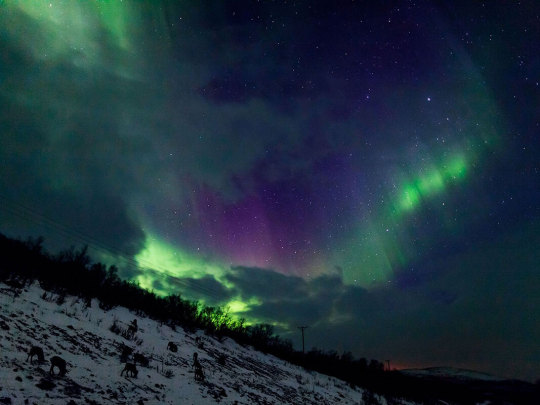
The aurora borealis (northern lights) dance above reindeer in the snow-covered Abisko National Park, Sweden. Taking the overnight train from Stockholm to Abisko is one of the best ways to see the night sky display in the country.
PHOTOGRAPH BY BABAK TAFRESHI, NAT GEO IMAGE COLLECTION
#babak tafreshi#photographer#national geographic#aurora borealis#northern lights#landscape#reindeer#abisko national park#sweden#night photography#nature#stockholm
36 notes
·
View notes
Text
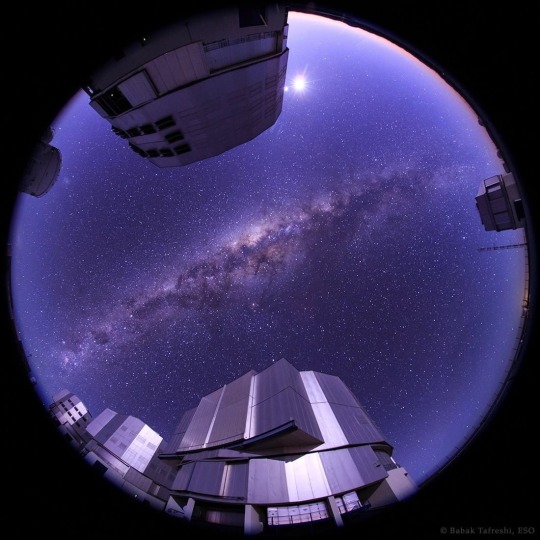
TODAY'S FROZEN MOMENT - 10th Anniversary of this amazing shot... March 27th, 2014 -
As dawn broke over the Paranal Observatory in Chile, visiting photographer, Iranian Babak Tafreshi, photographed the Milky Way - or at least the center of it - as it passed directly overhead....this fisheye shot truly producing a moment of awe... Tafreshi is the founder and director of The World at Night, a group of photographers who work to share the beauty of the night sky... a star chaser and immensely talented shooter... his work is life-affirming and stunning… and great for the soul...
(Mary Elaine LeBey)
+
We are travelers on a cosmic journey, stardust, swirling and dancing in the eddies and whirlpools of infinity. Life is eternal. We have stopped for a moment to encounter each other, to meet, to love, to share. This is a precious moment. It is a little parenthesis in eternity.
“The Alchemist” by Paulo Coelho
[alive on all channels]
#space#the Milky Way#Babak Tafreshi#photography#Mary Elaine LeBey#alive on all channels#The alchemist#Paulo Coelho
23 notes
·
View notes
Text
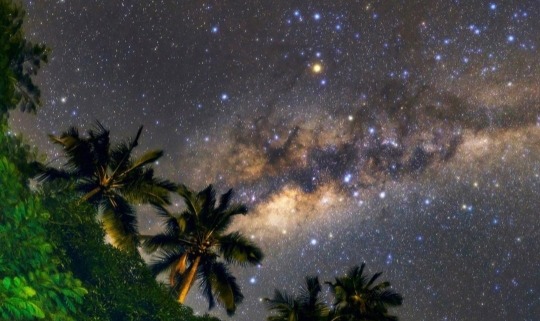
The Mily Way photographed in Ilha Grande, Brazil by Babak Tafreshi 2020-05-14
#The Milky Way#Milky Way#Brazil#Ilha Grande#babaktafreshi#photography#night sky#sky#palm trees#stars#galaxy#2020#Babak Tafreshi
3 notes
·
View notes
Photo
[source]

Rio Morning Moonset
Credits: Babak Tafreshi, TWAN
167 notes
·
View notes
Text
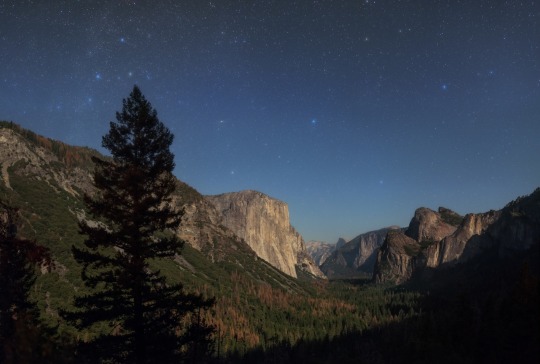
The Andromeda constellation, also known as the Chained Maiden, is seen over the El Capitan vertical rock formation in Yosemite National Park in California. To the surprise of many people, it can be spotted with the naked eye on a clear night from August through February. Photograph By Babak Tafreshi, National Geographic Image Collection
5 Famous Constellations That (Almost) Anyone Can Find
From Andromeda to Ursa Major, these cosmic landmarks dominate the sky. Learning how to spot them will turn you into a star gazer.
— By National Geographic Staff | August 23, 2023
The night sky is so vast; where do you start? Finding your way through the sky begins with a few dominant constellations, containing everything from star clusters and nebulae to obscure galaxies. If you keep looking upward, you’ll see these five constellations parade throughout the sky and through the seasons.
1). Andromeda (The Chained Maiden)
Andromeda, the Chained Maiden constellation, can be seen from August through February. This large constellation in the northern sky is conspicuous thanks to its attachment to the neighboring constellation Pegasus and that constellation’s Great Square asterism. The brightest star, Alpheratz, which represents the head of the maiden, happens to be shared with Pegasus. This blue giant star lies 97 light-years from Earth and shines 200 times brighter than our sun. Four main stars of Andromeda form a curved line toward the east, with Mirach representing her hips and Almach her chained foot. Although Mirach is nearly identical in brightness to Alpheratz, it is a larger red giant 197 light-years away.
Although Andromeda is considered a northern constellation, most of its stars can be glimpsed from the Southern Hemisphere, but always near the horizon, making it a bit trickier to observe its famous deep-sky objects. The most celebrated of these is the grand spiral called the Andromeda galaxy, or Messier 31. This, the closest large galaxy to our Milky Way, lies 2.5 million light- years away. To the surprise of many people, it can be spotted with the naked eye from a typical suburban backyard on a clear autumn night. It represents one of the farthest objects the unaided human eye can see in the universe.
2). Canis Major (The Great Dog)
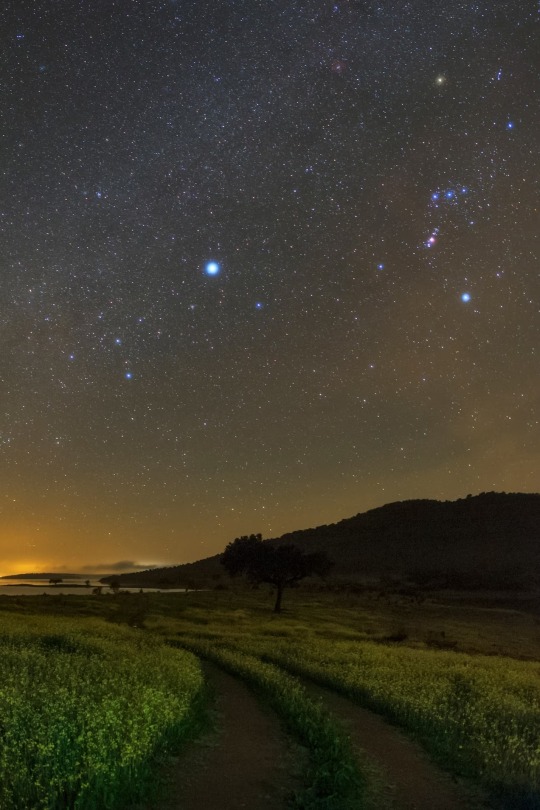
To locate Canis Major, also known as the Great Dog, look for the brightest star in the sky, Sirius, which is seen here above Alqueva Dark Sky Reserve in Portugal. Sirius is actually Canis Major’s sparkling eye. Photograph By Babak Tafreshi, National Geographic Image Collection
Canis Major is the larger of the two faithful hunting dog companions to Orion, the Hunter (explained below.) Standing by the Hunter’s foot, the Great Dog is an easy-to-find constellation visible from most areas of the world, thanks to being positioned just south of the celestial equator. Canis Major’s sparkling eye is the brightest star in the sky: Sirius.
The dog days of summer were named specifically for the Dog Star. In the Northern Hemisphere, ancient sky-watchers noticed the intensely bright star would rise and set with the sun. The combined power of the two suns was thought to be the cause of the stretch of hot weather experienced in late summer.
For binoculars and telescopes, Canis Major is rich in star clusters. Leading the pack is the beautiful open cluster M41, also known as the Little Beehive, which lies only four degrees south of Sirius. Containing some 80 stars, this fourth-magnitude cluster is 2,300 light-years away, yet is visible as a hazy patch to the naked eye on a dark night. It is an impressive sight through a backyard telescope, with orange stars scattered within.
3). Orion (The Hunter)
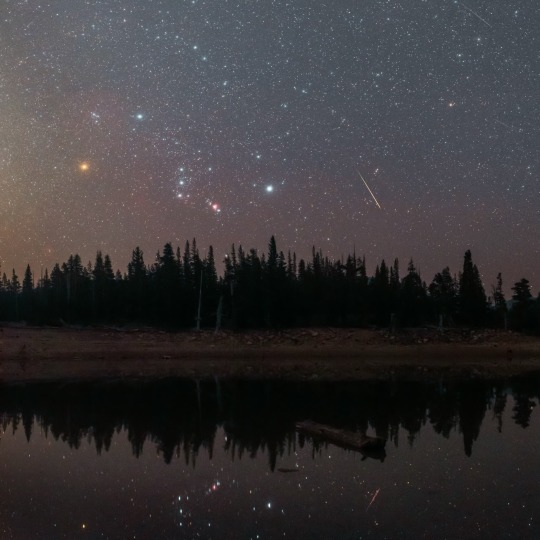
Orion, the Hunter, is seen just above the tree line by Mammoth Lakes in California. One of the oldest constellation figures, many stories are attached to Orion, a great hunter in Greco-Roman myths. Photograph By Babak Tafreshi, National Geographic Image Collection
Visible across the world, Orion is one of the most identifiable as well as one of the oldest constellation figures, crossing cultures and thousands of years. Orion straddles the celestial equator, so it is well known to observers in both the Northern and Southern Hemispheres and holds the record for containing the most bright stars in one stellar pattern.
Many stories are attached to Orion, a great hunter in Greco-Roman myths. The most famous says that he was stung by a scorpion (Scorpius) in an epic battle, which is why the two figures have been placed in opposite parts of the sky. Orion boasts two first-magnitude stars, with Betelgeuse marking the shoulder to the viewer’s left and Rigel his foot on the right. Sitting between Rigel and Betelgeuse is Orion’s stellar line of three stars, Alnitak, Alnilam, and Mintaka, marking the Hunter’s belt.
Orion includes an area of the Milky Way that features intense star production. Beneath the Hunter’s belt, in the middle of three stars that form Orion’s sword, is the Orion Nebula (M42). Visible to the naked eye as a fuzzy, faint patch, in backyard telescopes delicate wreathlike structures show where star formation is taking place at a furious pace.
4). Crux (The Southern Cross)
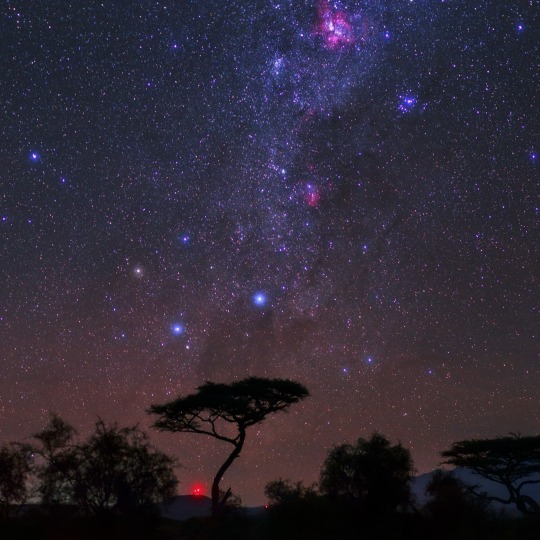
Crux, also known as the Southern Cross, can be found just above the silhouette of an acacia tree in Amboseli National Park in Kenya. Its distinctive cross asterism is marked simply by four bright stars. Photograph By Babak Tafreshi, National Geographic Image Collection
One of the most famous of all southern constellations, Crux is the smallest constellation in the sky, yet it is among the most recognizable. Its distinctive cross asterism is marked simply by four bright stars. In ancient times before Earth’s precession shifted the stars toward the south, the stars of Crux were visible from Europe. But it wasn’t until the 17th century, when European navigators sailing south recognized the cross-like pattern, that Crux became its own official constellation. While best explored from south of the Equator, keen-eyed sky-watchers as far north as the southern tip of Florida can glimpse the Southern Cross.
Crux straddles a rich section of the southern Milky Way band and so is filled with deep-sky treasures of all kinds. Just east of Crux lies what appears to be a hole in the sky—a dark region devoid of stars known as the Coalsack Nebula. It is clearly visible to the naked eye as a strikingly large, dark gas cloud silhouetted against a bright star-studded Milky Way.
5). Ursa Major (The Great Bear)
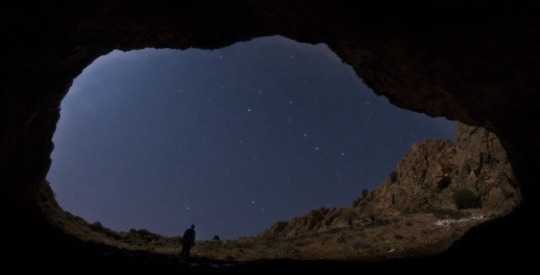
Ursula Major, which includes the Big Dipper, is seen framed by the top of the entrance to Roodafshan Cave in Iran. Also known as the Great Bear, the Big Dipper in this constellation represents the bear’s rear torso and tail, with the other stars of the constellation mapping out its long nose and legs. Photograph By Babak Tafreshi, National Geographic Image Collection
Ursa Major, also known as the Great Bear, is one of the most prominent northern constellations, and its main claim to fame is that it contains the Big Dipper, a highly recognizable asterism. The easily identifiable Big Dipper represents the bear’s rear torso and tail, with the other stars of the constellation mapping out its long nose and legs. For most observers in the Northern Hemisphere, the Great Bear is close enough to the north celestial pole that it never sets below the horizon, and it rotates around the North Star once a day.
While to the ancient Greeks this stellar group represented a large bear, other cultures saw everything from a chariot to a horse and wagon, a team of oxen, and a hippopotamus (by Egyptians, who had likely never seen a bear). Some Native American tribes believe the cup of the dipper represents a bear and the stars in the handle represent warriors who pursue it.
Finally, remember that you will get your best viewing on moonless nights away from brightly lit areas. Give your eyes time to adjust to the darkness—and good hunting!
#National Geographic#5 Famous Constellations 🌌#Andromeda (The Chained Maiden)#Canis Major (The Great Dog)#Orion (The Hunter)#Crux (The Southern Cross)#Ursa Major (The Great Bear)#Photographer | Babak Tafreshi
0 notes
Text
Celestial ~ Credit: Babak Tafreshi @wonders_of_the_cosmos
4 notes
·
View notes
Text

One of the National Geographic 2024 Pictures of the Year:
Millions of bats take off for their nightly feed. Photographs by Babak Tafreshi at Concan, Texas. Science photojournalist Babak Tafreshi went to Frio Bat Cave in southern Texas, where approximately 10 million Mexican free-tailed bats fly out most nights during the spring and summer. He chose this location to document the April 8 solar eclipse while answering a fascinating question: Will nocturnal bats get confused by the celestial event and emerge from their roost in the middle of the day? The answer turned out to be no (though some swallows near the cave entrance came out that afternoon very confused). As Tafreshi prepared for the eclipse in the days before, he used a 30-second exposure with a fish-eye lens to make this captivating image of the bats’ nightly coordinated stream as they exited the cave to feed on insects. “As I watched them, there wasn’t one collision between two bats,” he says. “It’s amazing how well-coordinated they are.”
3 notes
·
View notes
Photo

The Milky Way shimmers above a partially drained Horseshoe Lake, in Mammoth Lakes, California.
PHOTOGRAPH BY BABAK TAFRESHI, NAT GEO IMAGE COLLECTION
#babak tafreshi#photographer#national geographic#landscape#milky way#night sky#horseshoe lake#mammoth lakes#california#nature
29 notes
·
View notes
Text
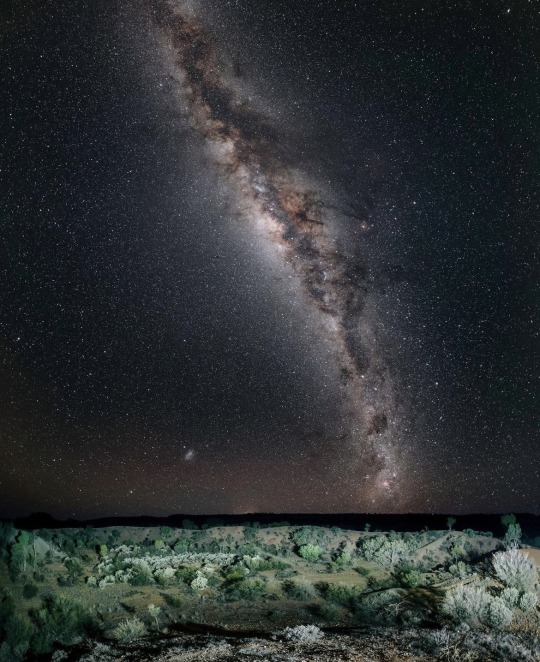
Milky Way over Australia by Babak Tafreshi
* * * *
Thank you Viktor Frankl.
He spoke of “a will to meaning in contrast to the pleasure principle (or as we could also term it, the will to pleasure) on which Freudian psychoanalysis is centered, as well as in contrast to the will to power.” Many were murdered outright, but in the harsh conditions of the camp those who lost their sense of purpose more readily died; those who had something to live for struggled and sometimes survived. Frankl concluded that it is “a dangerous misconception of mental hygiene to assume that what man needs in the first place is equlibrium or, as it is called in biology, ‘homeostasis,’ i.e., a tensionless state. What man actually needs is not a tensionless state but rather the striving and struggling for a worthwhile goal, a freely chosen task. What he needs is not the discharge of tension at any cost but the call of a potential meaning waiting to be fulfilled by him. . . . If architects want to strengthen a decrepit arch, they increase the load which is laid upon it, for thereby the parts are joined more firmly together.”
(Man’s Search For Meaning)
#Milky Way#Australia#sky#the heavens#heaven and earth#Man's Search for Meaning#Purpose#Viktor Frankl#quotes
12 notes
·
View notes
Photo
itsfullofstars:
APOD: Rio Morning Moonset
Image Credit & Copyright: Babak Tafreshi (TWAN)
Explanation: As the Sun rose, a nearly full Moon set in this serene seaside vista captured last Monday from Rio de Janeiro, Brazil. In the foreground, the reddened early morning sunlight illuminates a stretch of South Atlantic coastline. Looking toward the west, a scene that is a familiar one to Rio’s Ipanema beach goers, the favela Vidigal is nestled below the twin peaks of Morro Dois Irmãos (Two Brothers Hill). This well-composed multiple-exposure image recorded the steady progress of the dramatic moonset with a 6.5 minute gap between each frame. Flying from their nests at the break of dawn, all the ocean birds appear only in the last single frame.
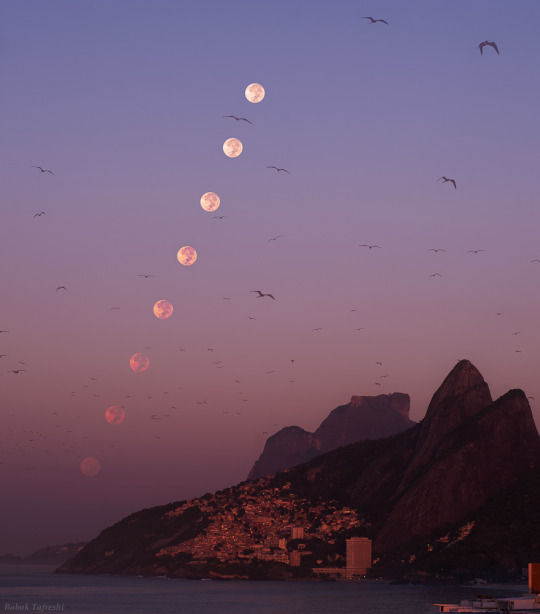
1K notes
·
View notes
Text
Conversations with Babak Tafreshi: A National Geographic Explorer astrophotographer discusses shooting the solar eclipse (with tips!)
On April 8, over 32 million Americans will witness a total solar eclipse, the last until 2044. ABC News and National Geographic will host “Eclipse Across America,” broadcasting live from 2:00 p.m. EDT across multiple platforms, including ABC, National Geographic Channel, Disney+, and Hulu. Anchored by David Muir and Linsey Davis from Burlington, Vermont, the program features Nat Geo talents like…
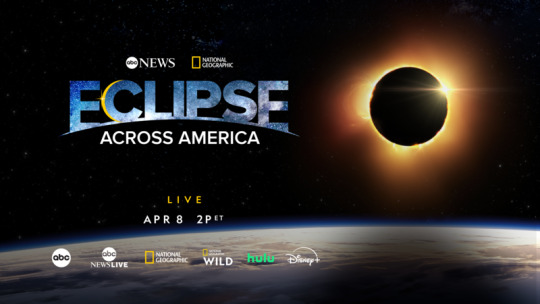
View On WordPress
#Africa#Asia#astronomy#Australia#Europe#Featured#North America#photography#solar eclipse#South America
1 note
·
View note
Text
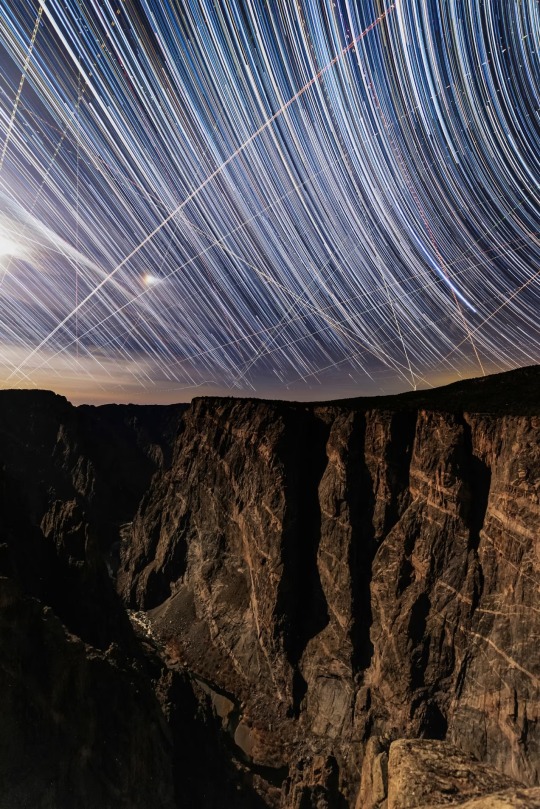
This long exposure photo of the sky above Gunnison National Park in Colorado shows the movement of light—coming from both natural and artificial sources. The thousands of satellites in orbit around the earth can shine millions of times brighter than objects farther away in space, getting in the way of astronomic observations. Photograph By Babak Tafreshi
It Looked Like A Bizarre Alignment of Meteors. It Was Something Else.
Astronomers are calling arrays of thousands of Satellites, like that of Starlink’s, “Mega Constellations” because of their overwhelming presence in the night sky.
— By Terry Ward | August 11, 2023
A fleet of UFOs, a bizarre alignment of meteors, a drone show: These are just a few of the things SpaceX’s Starlink satellites have been mistaken for of late.
National Geographic photographer Babak Tafreshi, however, knew exactly what he was seeing on a recent July evening in California’s Pinnacles National Park, when a “caravan of satellites” paraded across the sky, aligned as if they were perfectly-spaced stars.
“I see them very often because there are just so many of them,” he says. “People react because they have no idea what it is.”
These satellites bring broadband internet to some of the planet’s most remote reaches. They are usually seen in low-earth orbit (around 186 miles from ground) on their way up to their final orbit at 342 miles high. As they rise, they grow dimmer and spread out until they’re mostly out of sight of the naked eye, which can take up to several weeks. Astronomers call these massive arrays of satellites “mega constellations.”
In recent months, these satellites are being launched more frequently, often with over 50 satellites at a time, by Elon Musk’s commercial space company. Sightings of Starlink mega constellations are also becoming more common, says David J. Helfand, a professor of Astronomy at Columbia University.
The satellites are making it much more difficult for astronomers to do their jobs, he says. “When a satellite goes through the field of view of a telescope, it’s extremely bright,” Helfand says. “The objects we’re trying to study–distant galaxies and stars–are 20 million times fainter than satellites. So when one of these streaks goes across the image, it completely obliterates the image.”
At least 6 percent of the 2021 images from the Hubble Space Telescope were “compromised or completely ruined” by satellite interference by Starlink satellites, he says. “That’s when there were only 1,500 Starlink satellites…Now there are three times that amount.” And many more are on the way.
Satellites: An Invaluable Tool, An Astronomic Obstacle
In a February press release, SpaceX said they’d launched “nearly 4,000 satellites” over the last five years. They aim to send up to 42,000 satellites into its mega constellation in coming years, according to Space.com. SpaceX did not respond to National Geographic’s request for comment.
These satellites can be seen with the naked eye in the days following their launch (when their orbit is lower to Earth and satellites are still close enough together to appear in a line), and in the hours just after sunset and just before sunrise. Websites like Heavens-Above.com predict when Starlink satellite trains will pass overhead for people looking to spot them.
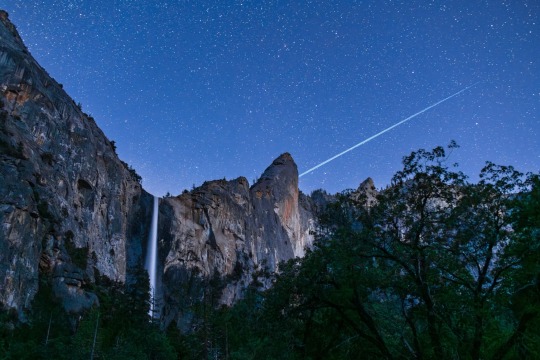
Starlink satellites travel across the night sky above Yosemite National Park, California. Photograph By Babak Tafreshi
Satellites like Starlink’s have long been used to enhance mobile services like cell phone coverage, internet and GPS navigation for people on Earth. Satellites also make weather forecasting, TV signaling, radio, and military surveillance possible.
But before Starlink launches, there were no “trains of satellites” to be seen, says Tafreshi. SpaceX uses new satellites that can be folded up in the dozens and sent into space on private rocket launches out of Cape Canaveral in Florida and Vandenberg Space Force Base in California.
“You used to see a couple of satellites at the beginning of the night and it was very cool to see a ‘moving star’ in the sky,” Tafreshi says. “Now, every direction you look there are a few moving above you. They’ve stolen the show from the stars.”
While Starlink satellites in low-earth orbit aren’t the brightest man-made objects in the sky, it’s the sheer number of them that’s worrying, says James Lowenthal, professor of astronomy at Smith College. “Starlink’s appear very bright when they're first launched into low orbit—brighter than the great majority of naked-eye stars,” he says. They become fainter as they are both moved to higher orbit as well as actively controlled to face certain directions–primarily for their own communication, but in part to make them appear dimmer, too.
Other companies with mega constellation projects in the works include Amazon’s Project Kuiper, currently planning a mega constellation of 3,236 satellites for broadband internet purposes. AST SpaceMobile’s BlueWalker 3 will start with 100 satellites and they may be brighter than 99.8 percent of visible stars, according to New Scientist.
Regulating Our Skyscape
When Lowenthal witnessed Starlink’s first satellite launch in 2019, he says he knew “the sky would never be the same again.”
A lack of international regulation and environmental oversight is endangering the sanctity of our skies like never before, says Aparna Venkatesan, a professor in the department of physics and astronomy at the University of San Francisco.
"We have no framework in place to conduct environmental assessments of all phases of satellite constellations, from launches to in-orbit operation to decommissioning,” she says.
Thousands of satellites break down in the atmosphere, leaving an estimated million pieces of space debris “criss-crossing at high relative speeds” and increasing the chance of collision with other space crafts, a 2021 paper asserts. These rockets also leave behind sooty discharge called black carbon, which could cause “changes in the global atmospheric circulation and distributions of ozone and temperature,” according to a 2010 paper.
Satellites contribute to light pollution by reflecting the sun’s light and also by their sheer numbers. Dark Skies organizations are fighting to minimize artificial light at night both to protect local ecosystems, and also to respect communities whose identities are closely tied to the night sky.
“Rapidly growing ground- and space-based light pollution is erasing Indigenous stories and identities—again—as history is painfully repeated for marginalized communities already disproportionately impacted by climate change and other crises,” Venkatesan says.
SpaceX has “done some due diligence,” says Vishnu Reddy, director of the Space4 Center at the University of Arizona, which measures the brightness of Starlink mega constellations and their impacts on ground-based astronomy.
Newer Starlink satellites “don’t reflect as much,” as the first generation satellites from 2019 and 2020, Reddy says, and some older ones have also been “deorbited‚”—falling out of orbit and burning up in the atmosphere.
Lowenthal agrees that SpaceX “quickly heard the alarm from astronomers around the world,” engaging in conversations with astronomers from the company’s first Starlink launch. “What they haven’t done, however, is slow down launches,” he says. “We have always relied on our ability to turn to the night sky for solace and personal connection as well as scientific study…that’s all threatened.”
#Meteors#Bizarre Alignment#Mega Constellations 🌌#Starlink#Satellites 🛰️ 📡#Skyscape#Astronomic Obstacle#Terry Ward#National Geographic
2 notes
·
View notes
Link
Navigation satellites couldn’t accomplish anything without extremely accurate clocks. But a regular clock won’t do. Only atomic clocks are accurate enough, and that’s because they tell time with electrons. Those atomic clocks wear out over time, and that’s what the image shows. The strange forms are reminiscent of penitentes, the unusual landscape features found in cold environments like the Atacama desert. They’re also found on Pluto, though they’re the size of skyscrapers there. This alien-looking landscape shows penitentes in the Atacama Desert. Penitentes are made of snow that’s sculpted by the Sun and sublimation. Image Credit: ESO Photo Ambassador Babak A. Tafreshi. The leading image has nothing to do with alien landscapes. It’s from a scanning electron microscope. It shows the surface of test glass from a project aimed at improving the lifetime of atomic clocks in the Galileo Navigation Satellite System (GNSS.) Each of these peculiar marks is smaller than one-hundredth of a millimetre. They’re the result of plasma interacting with the glass surface inside an atomic clock and degrading it over time. The ESA is working on improving the atomic clocks in the GNSS. The system has 30 satellites, with 24 in full service and six acting as spares. Each of the satellites has four atomic clocks: two passive hydrogen maser (PHM) clocks and two rubidium clocks as backups. In 2017, six of the hydrogen and three of the rubidium clocks on some of the satellites failed. Operations weren’t affected because of the backup clocks. But failures like it are driving the ESA to improve the clocks. The clocks on the GNSS last about 20 years, and the ESA would like to extend their lifetime. This is one of the passive hydrogen maser clocks that are inside the GNSS satellite. It’s about 50 cm (19.6 inches) long. Image Credit: Leonardo Airborne and Space Systems. Passive hydrogen masers are based on electrons orbiting atoms. Electrons can gain and lose energy, and each time they do, they change energy states. In a PHM, a maser is used to stimulate electrons into changing energy states. When they do, they emit microwave signals at an extremely stable frequency. That stability gives the clocks on the Galileo satellites their extreme accuracy: they’re only off by one second every three million years. PHMs are extremely complex. A detailed description of how they work is here. Two separate glass bulbs play key roles in the clock and its accuracy. One is a plasma confiner, and inside of it, hydrogen molecules are separated into hydrogen atoms. But the plasma degrades the inside of the bulb, and the degradation affects the atomic clock’s lifetime. The leading image shows the damage on the inside of the glass bulb caused by the plasma and associated effects. The goal is to extend the life of the bulb, which extends the life of the clocks, and the life of each satellite in the GNSS. Accuracy is extremely important in navigation satellites. Even a tiny inaccuracy can compound and lead to larger errors. That’s why these extremely complex and accurate PHMs are used. If the clocks are out by as little as three nanoseconds, then a user’s location on the Earth’s surface can be off by one meter. But accuracy isn’t a problem. The lifetime of the PHMs is the bottleneck. The ESA and EU are planning their next generation of Galileo satellites, a system that serves over four billion users. It’s called Galileo Second Generation (G2G) and will begin deploying this year. These tests are aimed at making these and future navigation satellites have longer lives. The post This Alien Landscape is Actually a Microscopic View of an Atomic Clock appeared first on Universe Today.
0 notes


